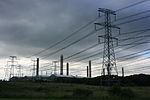Ellington Colliery

Ellington Colliery (also known as The Big E), was a coal mine situated to the south of the village of Ellington in Northumberland, England. The colliery was the last deep coal mine in the north east of England (also known as the Great Northern Coalfield). At one time, the deepest part of the mine was 800 metres (2,600 ft) and it extended 15 miles (24 km) under the North Sea. During the 1980s, the pit (along with Lynemouth Colliery) was known as the biggest undersea mine in the world and produced 69% of the mined coal in Northumberland. Ellington had several faces for mining and was known for winning coal from under the North Sea, before flooding caused the early closure of the mine.
Excerpt from the Wikipedia article Ellington Colliery (License: CC BY-SA 3.0, Authors, Images).Ellington Colliery
Lynemouth Road,
Geographical coordinates (GPS) Address Nearby Places Show on map
Geographical coordinates (GPS)
| Latitude | Longitude |
|---|---|
| N 55.217 ° | E -1.555 ° |
Address
Lynemouth Road
NE61 5HB , Ellington and Linton
England, United Kingdom
Open on Google Maps









